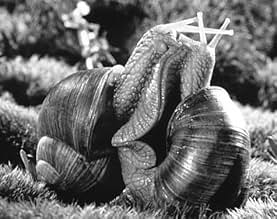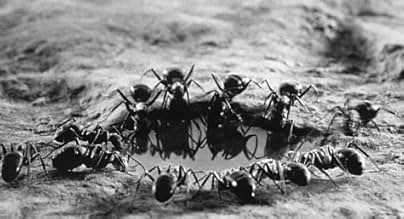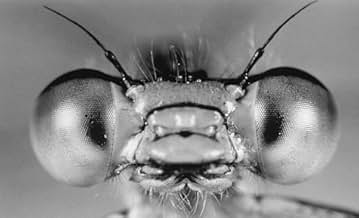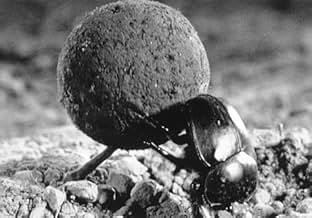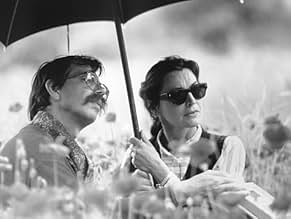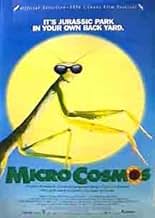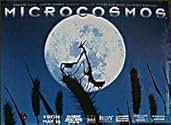CALIFICACIÓN DE IMDb
7.9/10
12 k
TU CALIFICACIÓN
Agrega una trama en tu idiomaA documentary on insect life in meadows and ponds.A documentary on insect life in meadows and ponds.A documentary on insect life in meadows and ponds.
- Dirección
- Guionistas
- Elenco
- Premios
- 9 premios ganados y 9 nominaciones en total
- Dirección
- Guionistas
- Todo el elenco y el equipo
- Producción, taquilla y más en IMDbPro
Opiniones destacadas
This film gives an incredible account of insects and other little creatures many of which are known to home gardeners who are continually fighting a battle against them. But here we see the insect life in all its intriguing detail and wondrous colour. The photography is superb. It's a pity more attention was not given to the sound which comes and goes in an unpredictable fashion. There is very little commentary so one must just accept the beauty of each particular shot. One does not have to be a zoologist to enjoy this strange world the inhabiatnts of which outnumber humans on planet earth.
There is some sound e.g. the flutter of wings and the buzzing of bees but much of the film is silent as one might expect in a world of insects. Music accompanies some of the scenes adding a degree of drama. Two slimy snails are seen touching and fondling each other indicating unmistakably that foreplay has begun and sexual union will follow as the choral music climaxes. The photographers must have a rare patience to record such intimate and detailed incidents.
The film is not without its humorous moments. I thought the caterpillars marching in single file were an absolute gem and evoked genuine laughter. Fascinating too was Mr. Spider working at lightning speed as he wrapped in a shroud his most unfortunate victim.
I found it even more enjoyable on second viewing.
There is some sound e.g. the flutter of wings and the buzzing of bees but much of the film is silent as one might expect in a world of insects. Music accompanies some of the scenes adding a degree of drama. Two slimy snails are seen touching and fondling each other indicating unmistakably that foreplay has begun and sexual union will follow as the choral music climaxes. The photographers must have a rare patience to record such intimate and detailed incidents.
The film is not without its humorous moments. I thought the caterpillars marching in single file were an absolute gem and evoked genuine laughter. Fascinating too was Mr. Spider working at lightning speed as he wrapped in a shroud his most unfortunate victim.
I found it even more enjoyable on second viewing.
10danila_1
I saw the Winged Migration before this one and I though that was the most beautiful and amazing films ever made. I never though I would be proved wrong soon. Microcosmos has everything Winged Migration has, such as amazing cinematography, beautiful music and the best studio ever, our planet, it also has something more - the whole new world to show that most people don't realise exists. "Look at your feet, this funny world." starts the beautiful song while the opening credits roll and we are treated to a beautiful flight through the clouds. The camera pans down, to the forest and then lower still. Thus starts the most amazing journey you ever saw on film and for the next hour you can't take your eyes of the screen.
Palm trees, anakondas, space aliens... Grass and insects actully, but shown in the way you never thought possible. Who would have known that the sight of two snails making tender love is so cute and lovely, that spiders are so scary, dung-beetles are so funny and waterdrops so heavy? Watch how grass grows, flowers open in the morning, insects eat plants, plants eat insects, insects make love to other insects, plants and vice versa, chrysalis change into butterfly, etc., etc. And did I mention tender snail lovemaking? :)
There is whole new world under our feet. Everything so small and so amazingly beautiful at the same time. Don't let it stay unnoticed. Go and watch this film immediately (and see Winged Migration as well).
Palm trees, anakondas, space aliens... Grass and insects actully, but shown in the way you never thought possible. Who would have known that the sight of two snails making tender love is so cute and lovely, that spiders are so scary, dung-beetles are so funny and waterdrops so heavy? Watch how grass grows, flowers open in the morning, insects eat plants, plants eat insects, insects make love to other insects, plants and vice versa, chrysalis change into butterfly, etc., etc. And did I mention tender snail lovemaking? :)
There is whole new world under our feet. Everything so small and so amazingly beautiful at the same time. Don't let it stay unnoticed. Go and watch this film immediately (and see Winged Migration as well).
It was undeniably beautiful. Take a meadow in France that appears to consist of nothing but grass, and show us what wonders there are to be seen if you lower your eyes and look at the very very small...
Insects (and arachnids and teensy molluscs) offer a possible advantage over, say, lions; in that with insects, cinematography really comes into its own. If you want to show a lion catching an antelope then you have to point your camera at a likely spot and wait and wait and wait until the event occurs; and when it does, chances are that the lighting is at its worst, the background is less than ideal and you would have got a better view from somewhere else. The world of the tiny gives the fellow with the camera much more control, much more room to manoeuvre. It's much easier to hit upon the perfect angle from which to show the spider eating the grasshopper. I don't know if this is true; but it's one possible explanation for why the shots are so gorgeous, and why we feel we were given the best possible seats.
But if you find yourself asking, "What the hell was going on?" - well, you shouldn't have to ask. You should have been told. One of the reasons (I hope) for watching what is after all a documentary, is to find out WHAT GOES ON in an ordinary meadow; and if the producer thought that a human voice would destroy the sibylline loveliness of it all, that's just too bad - film-making isn't all pretty pictures. If you don't want David Attenborough doing the talking (although frankly, I don't see why you wouldn't), then find someone else or some other style of narration; or, perhaps, take more care to arrange the images so that the images themselves tell the story. I'm sure it could have been done. As it was I got the impression that we were shown ants getting hit by raindrops until they thought we must be tired of ants - and then we were shown something else.
I don't want to carp too much. The makers could well retort that books, rather than films, are ideally suited to explanation, and that they had simply made a film for us to watch AFTER we had read the relevant books. Perhaps they have a point. At any rate, we may remain in the dark, but we have a wonderful view.
Insects (and arachnids and teensy molluscs) offer a possible advantage over, say, lions; in that with insects, cinematography really comes into its own. If you want to show a lion catching an antelope then you have to point your camera at a likely spot and wait and wait and wait until the event occurs; and when it does, chances are that the lighting is at its worst, the background is less than ideal and you would have got a better view from somewhere else. The world of the tiny gives the fellow with the camera much more control, much more room to manoeuvre. It's much easier to hit upon the perfect angle from which to show the spider eating the grasshopper. I don't know if this is true; but it's one possible explanation for why the shots are so gorgeous, and why we feel we were given the best possible seats.
But if you find yourself asking, "What the hell was going on?" - well, you shouldn't have to ask. You should have been told. One of the reasons (I hope) for watching what is after all a documentary, is to find out WHAT GOES ON in an ordinary meadow; and if the producer thought that a human voice would destroy the sibylline loveliness of it all, that's just too bad - film-making isn't all pretty pictures. If you don't want David Attenborough doing the talking (although frankly, I don't see why you wouldn't), then find someone else or some other style of narration; or, perhaps, take more care to arrange the images so that the images themselves tell the story. I'm sure it could have been done. As it was I got the impression that we were shown ants getting hit by raindrops until they thought we must be tired of ants - and then we were shown something else.
I don't want to carp too much. The makers could well retort that books, rather than films, are ideally suited to explanation, and that they had simply made a film for us to watch AFTER we had read the relevant books. Perhaps they have a point. At any rate, we may remain in the dark, but we have a wonderful view.
Amazing. There must have been millions of hours of footage shot to obtain these perfect sequences of magnified nature. Each segment was fascinating, beautiful, in some cases strangely emotional.
My jaw was literally dropped through much of this film. I even found myself wowing like a hippy and chuckling like Butthead many times. There were even some moments that I almost said, "No, that's not realistic. They made that up."
The soundtrack was almost non-existent, so you appreciated it more when the haunting music worked its way into a scene. The sound quality of the actual critters was very good as well. There is nearly no narrative or narration throughout the film -and that would be my only criticism -there should have been NONE. The movie was spectacular with no commentary, and the human voice for a brief moment in the beginning and end detracted from the alien environment.
This movie was not a documentary, it was just fine filmmaking that would only fall into the genre of "mind-f---".
My jaw was literally dropped through much of this film. I even found myself wowing like a hippy and chuckling like Butthead many times. There were even some moments that I almost said, "No, that's not realistic. They made that up."
The soundtrack was almost non-existent, so you appreciated it more when the haunting music worked its way into a scene. The sound quality of the actual critters was very good as well. There is nearly no narrative or narration throughout the film -and that would be my only criticism -there should have been NONE. The movie was spectacular with no commentary, and the human voice for a brief moment in the beginning and end detracted from the alien environment.
This movie was not a documentary, it was just fine filmmaking that would only fall into the genre of "mind-f---".
Microcosmos is a magnificent journey, an experience to explore a world full of details and wonder. After watching this "documentary" you would never see another insect in the same way as before.
If you read some comments complaining about the little-to-non-existent narration is because they fail to understand this "documentary" is not about getting the facts straight. It is an experience and as such it is to be lived not to be told.
Sit on the grass, observe, and paint the daughter of the dragonfly.
If you read some comments complaining about the little-to-non-existent narration is because they fail to understand this "documentary" is not about getting the facts straight. It is an experience and as such it is to be lived not to be told.
Sit on the grass, observe, and paint the daughter of the dragonfly.
¿Sabías que…?
- TriviaFilmed over a period of three years.
- Citas
Narrator (English version): [beginning narration] A meadow in early morning, somewhere on Earth. Hidden here is a world as vast as our own, where the weeds are like impenetrable jungles, the stones are mountains, and even the smallest pond becomes an ocean. Time passes differently here: an hour is like a day, a day is like a season, and the passing of a season is a lifetime. But to observe this world, we must fall silent now, and listen to its murmurs.
- Créditos curiososIn the end credits: Le Conseil Général de L'Aveyron and SIVOM des Monts et Lacs du Lévezou extend the adventure in the world of insects at the Jean-Henri Fabre Center of Saint-Léons in Lévezou, opening in 1998.
Selecciones populares
Inicia sesión para calificar y agrega a la lista de videos para obtener recomendaciones personalizadas
- How long is Microcosmos?Con tecnología de Alexa
Detalles
- Fecha de lanzamiento
- Países de origen
- Idioma
- También se conoce como
- Çayırın Sakinleri
- Locaciones de filmación
- Productoras
- Ver más créditos de la compañía en IMDbPro
Taquilla
- Presupuesto
- CHF 5,000,000 (estimado)
- Total en EE. UU. y Canadá
- USD 1,433,210
- Fin de semana de estreno en EE. UU. y Canadá
- USD 35,189
- 13 oct 1996
- Total a nivel mundial
- USD 1,433,210
- Tiempo de ejecución1 hora 20 minutos
- Color
- Mezcla de sonido
- Relación de aspecto
- 1.66 : 1
Contribuir a esta página
Sugiere una edición o agrega el contenido que falta

Principales brechas de datos
By what name was Microcosmos (1996) officially released in India in English?
Responda
